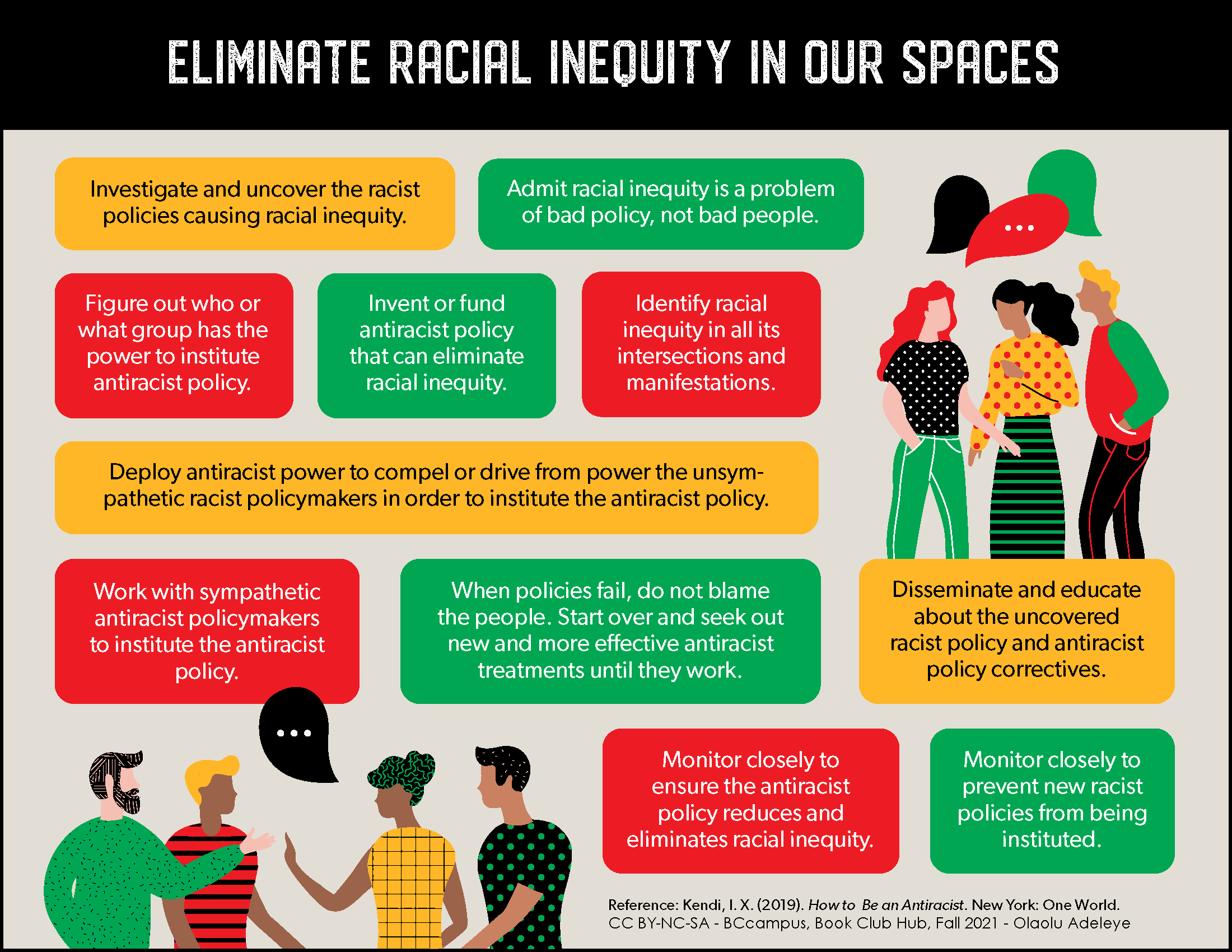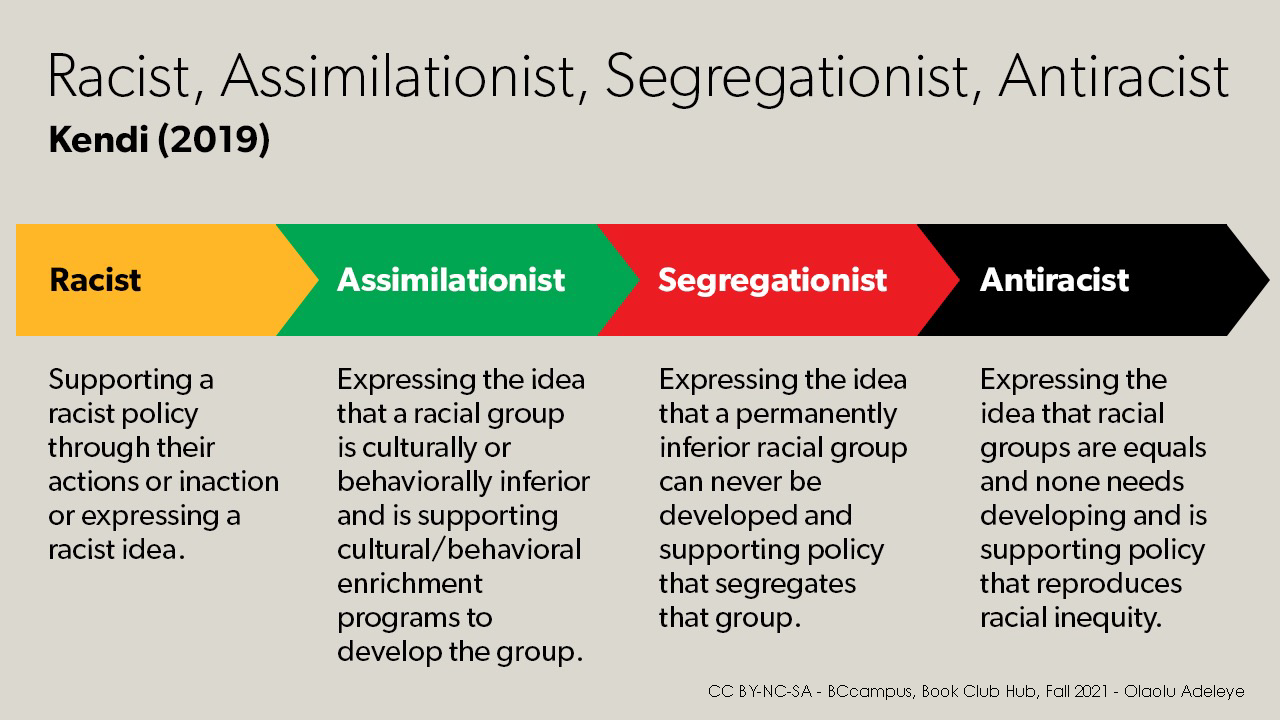Act 4: Solidarity and Success
Synthesis of Key Themes
- An aspirational post-racial world must first consider the idea of race and the impact of race stratification (Chapter 1).
- Within the anti-racist agenda, eliminating race categorization is the last objective; without race categorization, you cannot identify racial inequity or challenge racist policies (Chapter 4).
- High crime rates in certain neighborhoods are a byproduct of low-income and poverty rather than race (Chapter 6).
- Behavioural racism makes an individual responsible for the perceived behaviour of a particular racial group and uses the racial group as a justification for the behaviour of an individual (Chapter 8).
- To be anti-racist is to separate an individual’s culture from their behaviour (Chapter 8).
- Although White people may benefit from racist policies, there is a distinction between White people and racist power and racist policymakers (Chapter 9).
- The focus needs to be directed at racist power and racist policymakers rather than individuals (Chapter 9).
- The powerlessness argument is used to justify that racialized people can’t be racist because they do not have power. Racialized people do have power with people at all levels of power. The powerlessness arguments do not consider this (Chapter 11).
- Racist ideas lead racialized people to think the power is consolidated in the hands of White people. This in turn produces more racial tensions, which reproduce racist ideologies while defending racist policies (Chapter 11).
- We can all uphold a racist idea or a racist policy regardless of the colour of our skin. Our ideas can be racist today and anti-racist tomorrow; we must recognize our faults and our language that supports racism (Chapter 11).
- We must realize race is a social construct, but more importantly it is created to serve the interests of those in power and allow them to maintain this position (Chapter 16).
- The history of the racially oppressed is a duel between racist and anti-racist progress (Chapter 16).
- Hate and ignorance do not promote racist power. Racist policymakers are driven by economic, political, and cultural self-interest (Chapter 16).
- Making someone change their mind about racism is not activism; the goal of the activist is to produce power and steer political change, not mental change (Chapter 16).
Discussion Points
The following are some suggested themes and topics to be explored during this Act. Depending on your own frame of reference and the direction you hope to take, it may be helpful to do some preliminary research. Our suggestion is that you approach these themes in a variety of ways, including small group discussions, sharing circles, visual prompts, brainstorming activities, and annotations.
*Although you may be looking to offer contextual and factual information, prioritize establishing a collective understanding of your theme, and use this as a building block for further discussion and exploration with the group.
- Definitions
- Racist vs. Anti-Racist
- Biological
- Body
- Social Determinants of Health/Education
- The Personal Is the Political Is the Professional
- Urban Planning
- Surveillance
- Framing
- As a Tool for Contesting Power
- Restating the Narrative for “All”
- Success
- Case Studies (image provocations)
- To Be an Anti-Racist
- Individual
- Organizations/Institutions
Eliminate Racial Inequity in Our Spaces
Download the Eliminate Racial Inequality in Our Spaces Flowchart [PDF].

- Investigate and uncover the racist policies causing racial inequity.
- Admit racial inequity is a problem of bad policy, not bad people.
- Figure out who or what group has the power to institute antiracist policy.
- Identify racial inequity in all its intersections and manifestations.
- Invent or fund antiracist policy that can eliminate racial inequity.
- Disseminate and educate about the uncovered racist policy and antiracist policy correctives.
- Work with sympathetic antiracist policymakers to institute the antiracist policy.
- Deploy antiracist power to compel or drive from power the unsympathetic racist policymakers in order to institute the antiracist policy.
- Monitor closely to ensure the antiracist policy reduces and eliminates racial inequity.
- When policies fail, do not blame the people. Start over and seek out new and more effective antiracist treatments until they work.
- Monitor closely to prevent new racist policies from being instituted.
Racist, Assimilationist, Segregationist, Antiracist
Download the Racist, Assimilationist, Segregationist, Antiracist [PDF].
Racist, Assimilationist, Segregationist, Antiracist (Kendi, 2019, p.24).
- Racist: Supporting a racist policy through their actions or inaction or expressing a racist idea.
- Assimilationist: Expressing the idea that a racial group is culturally or behaviourally inferior and is supporting cultural/behavioural enrichment programs to develop the group.
- Segregationist: Expressing the idea that a permanently inferior racial group can never be developed and supporting policy that segregates that group.
- Antiracist: Expressing the idea that racial groups are equals and none needs developing and is supporting policy that reproduce racial inequity.
Reflective Questions
To Know
- Where do you feel safe and unsafe? How is this experience a function of a feeling associated with being a threat or threatened or experiencing a form of discrimination?
- In what ways do you see your personal, political, and professional life and affiliations reflecting one another?
To Be
- Thinking of your own intersectionality and your membership in various groups and circles:
- Who are some anti-racist leaders, and which tactics and specific forms of creative action or approaches have resonated with you?
- What is the first step you will take in striving to be an anti-racist?
- How is engaging in anti-racist work different for White people vs. racialized people?
To Do
- Considering the use of framing (Goffman, 1974) as a tool to contest power and to offer an alternate narrative:
- What theories do you believe can help us to better understand our worlds and the impetus we have to affect change?
- What are some ideas you have for facilitating exchanges that can help to effectively mobilize campuses, communities, and society at large to resist racism?
Check-In: Feeling, Orientation, Inspiration (FOI)
- Discuss one feeling that has surfaced for you during this Act.
- Reflect on one new orientation you’ve gained from this Act.
- Collectively brainstorm steps or actions this Act has inspired you to take.
Activity
Suggested Activity – Crafting an Anti-Racist Statement (Individual and Institutional)
Using the template below, build your own anti-racist statement.
Individual – “I”
Advice
- A – Acknowledge – I understand that…
- D – Disrupt – I commit to…
- V – Volunteer – I shall give of…
- I – Iterate – I will continue to…
- C – Commit – I can take steps to…
- E – Explain (how) – I resolve that…
Institutional – “We”
Advocate
- A – Acknowledge – We understand that…
- D – Discuss – We have learned that…
- V – Volunteer – We will give…
- O – Operationalize – We plan to…
- C – Commit – We are committed to…
- A – Aspire – We aim to…
- T – Take on – We resolve/hope that….
- E – Explain/Execute – We shall do this by/through…
Facilitator Tips
- “We suggest you use Mentimeter to collectively brainstorm some of the gaps within your sector.
- Remind participants to focus on highlighting their personal understanding and learnings with an emphasis on who they are, using positive affirmation rather than negative critiques about themselves or their organization.
- Create something that is both reflective of today and aspirational.
- This is not a static exercise; as your group’s knowledge expands, so too does the content. Be open to iteration.
Suggested Resources
Articles
Vargas, J. A. (2011, June 22). My life as an undocumented immigrant, The New York Times Magazine. https://www.nytimes.com/2011/06/26/magazine/my-life-as-an-undocumented-immigrant.html.
Scott Gilmore, S. (2015, January 22) Canada’s race problem? It’s even worse than America’s, Maclean’s. https://www.macleans.ca/news/canada/out-of-sight-out-of-mind-2/.
DasGupta, N., Shandal, V., Shadd, D., Segal, A., & in conjunction with CivicAction. (2020, December 14). The pervasive reality of anti-Black racism in Canada, BCG. https://www.bcg.com/en-ca/publications/2020/reality-of-anti-black-racism-in-canada.
Multimedia
Beautiful Trouble, Toolbox (n.d.), https://www.beautifultrouble.org/toolbox.
City of Saskatoon. (2011). Video 1: Tim Wise on the Legacy of Institutionalized Racial and Ethnic Discrimination. [Video.] https://www.youtube.com/watch?v=0McOGoxf7Bo.
Government of Canada. (2019). Building a Foundation for Change: Canada’s Anti-Racism Strategy. http://publications.gc.ca/collections/collection_2019/pch/CH37-4-29-2019-eng.pdf
Definitions
|
bi· o· log· i· cal (/bī-ə-ˈlä-ji-kəl/) |
(Kendi, 2019, p. 44) |
|---|---|
|
bod·y (/ˈbädē/) |
(Kendi, 2019, p. 69) |
Discuss and describe key content themes.
Unpack and elaborate on the definitions Kendi proposes.
Discuss the intersectional forms of racism that exist and their implications for individual experiences.
Gain a greater understanding of critical race theory, intersectionality, and other frameworks that offer context for the multidimensional nature of racism.
Consider and apply key learnings to various contexts.
Discuss implications of racism both individually and structurally.
Look at what racism means in the Canadian context.
Understand what racism means within global structures and systems.
Connect ideas across multiple contexts, including personal, professional, and pedagogical.
Recognize and identify personal steps to become an anti-racist.
Gain awareness of individual biases and the impact of our schemas on both our own and others’ experiences with racism.
Engage openly and authentically.
Communicate appropriately for various contexts, audiences, and purposes.
Facilitate and support others to have conversations about racism.
Recognize the importance of humility to anti-racism.
Apply intersectional and transdisciplinary lenses to the multidimensional elements of individual experience.
Consider and apply key learnings to various contexts.
This includes self, society, and schools (specifically post-secondary education contexts).
Plan, design, and facilitate a book club, anti-racism task force, or similar equity, diversity, and inclusion undertaking at your institution.
Design and facilitate appropriate interventions that reflect an anti-racist approach and a pedagogy for self, society, and schools.
Apply learned methodology, frameworks, and techniques.
Create brave, safe, ethical spaces that allow for authentic sharing by approaching difficult conversations with generative discourse.
Effectively incorporate Book Club Hub resources, media, technology tools, and approaches to enhance communication and increase participants’ scope and understanding of the topics discussed.


